 by Peter Walker and Pieter Thomassen with Rob Morgenstern
by Peter Walker and Pieter Thomassen with Rob Morgenstern
I. Dimensions:
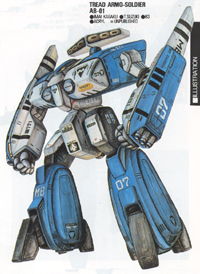
| Fighter | VTOL | Battloid |
|---|
| Total Length : | 9.7m | 8.0m | - |
| Total Depth : | - | - | 7.3m |
| Total Height (VF-12) : | 6.1m | 8.5m | 13.7m |
| Total Height (VE-12) : | 7.2m | 9.6m | 13.9m |
| Total Breadth : | - | - | 8.5m |
| Total Wingspan : | 19.5m | 19.5m | - |
| Total Dry Weight: | 29.50 tons (metric) |
II. Type:
- VF-12: Single seat (VF-12B is a two-seat trainer), all-weather, aerospace combat mecha; two form Veritech with intermediate VTOL mode.
- VE-12: Five seat, all-weather, electronic intelligence/reconnaissance/Wild Weasel mecha; two form Veritech with intermediate VTOL mode.
III. Service History:
- VF-12A: Served with the Expeditionary Force Naval Air Arm from 2039 to 2046 and with the RDF Combined Planetary Forces and RDF Naval Air Arm from 2046 to 2047.
- VF-12B: Served with the Expeditionary Force Naval Air Arm from 2039 to 2046 and with the RDF Combined Planetary Forces and RDF Naval Air Arm from 2046 onwards.
- VF-12S: Served with the Expeditionary Force Naval Air Arm from 2043 to 2046 and with the RDF Combined Planetary Forces and RDF Naval Air Arm from 2046 onwards.
- VE-12A: Served with the Expeditionary Force Naval Air Arm from 2039 to 2046 and with the RDF Combined Planetary Forces and RDF Naval Air Arm from 2046 to 2047.
- VE-12S: Served with the Expeditionary Force Naval Air Arm from 2043 to 2046 and with the RDF Combined Planetary Forces and RDF Naval Air Arm from 2046 onwards.
IV. Propulsion:
- Engines:
- 3 x Pratt & Whitney JG102A [Main] Fusion plasma-air/reaction mass intermix turbines. Max output, 356 kN ea.
- 4 x Turbo-Union ATF 401 [Auxiliary] miniaturized fusion plasma-air/reaction mass intermix turbines. The engines are mounted in pairs near the elbow joint of the arm for VTOL operations in jet mode. Each engine is rated to 46.9 kN standard thrust, max overboost to 91.1 kN each.
- Assorted small reaction thrusters and gyroscopes for all-environment maneuvers, attitude adjustment, and stability.
- Powerplant : 4 x RRL-2D Miniaturized Protoculture-cell energizer
- Fuel Capacity:
- 32 Standard Canisters of Protoculture
- 38.2 lit. D2O reactant for fusion engines.
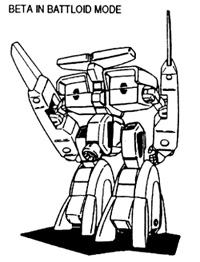
IV. Performance:
A. Fighter Mode:
- Max level speed : 1930 kph at 18km (Mach 1.8)
8900 kph at 45km with boosters
700 kph at sea level (Mach .7)
- Stall speed : 250 kph (VTOL rectification possible)
- Initial climb rate: over 40000m per minute with boosters
- Service ceiling : 35 km (Beta can be boosted into orbit)
B. VTOL Mode:
- Max loiter time : 120 seconds.
- Stall speed : None (VTOL)
- Service ceiling : 18000m
C. Battloid Mode:
- Max running speed : 128 kph
- Max flying speed : 482 kph
- Service ceiling : 2440m
D. General:
- Combat radius (space): total delta-v 11.8 kps, with internal reaction mass only. Two extra tanks for 2.8 kps delta-v each can be attached externally. These values are for the Beta alone. Coupled to the Alpha, these are reduced to 7.5 kps for the internals, and 1.8 kps for each external tank.
- Protoculture supply : 250 hours operational use.
- Design G limits : +12.0/-5.6 (Computer overrides at 9.5g)
VI. Electronics:
Radar tracking:
(VF-12A and -B models)
- Hughes APG-113 X-band pulse-Doppler, providing spherical long-range detection and tracking of targets at all altitudes.
(VF-12S models)
- Hughes APG-117 UWB pulse-Doppler phased array, providing spherical long-range detection and tracking of targets at all altitudes. Equipped with special 'stealthy' and passive modes.
(VE-12 models)
- Westinghouse APY-7 multi-band interleaved-multi-mode radar system, providing spherical very-long-range detection and tracking of targets at all altitudes in addition to medium range imaging and target identification. This system includes passive modes for "stealthy" detection of targets.
- Thomson ALQ-310 multi-band interleaved multi-spectrum passive sensor system, providing spherical and extremely sensitive detection, identification, comparison and data storage of EM radiation at all altitudes.
Optical tracking:
(VF-12 models)
- Two Zeiss/Thomson multi-spectrum high-sensitivity scanner booms. Each boom features a 30cm CCD-equipped Schmidt-Cassegrain telescope, a 27cm IR telescopic imager, and a 24cm ultra-violet telescope. These two booms are mounted on swiveling arms, and are, when not in use in jet or VTOL mode, folded between the upper main engine sections to avoid FOD damage to the somewhat delicate optics. When used in the above modes, and under normal circumstances in Battloid mode, the optics arms are folded out into a 'T' shape for stereoscopic operation.
- Phillips AllView multi-band digital camera system, for medium range spherical infra-red imaging, optical and ultra-violet band detection and tracking.
- Thomson LT-5 multi-frequency laser ranger and designator.
(VE-12 models)
- Zeiss/Thomson multi-spectrum high-sensitivity scanner system including 15cm IR telescopic imager and 13.5cm ultra-violet telescope. These optics have internal shields to protect them when not in use.
- Phillips AllView multi-band digital camera system, for medium range spherical infra-red imaging, optical and ultra-violet band detection and tracking.
- Thomson LT-5 multi-frequency laser ranger and designator.
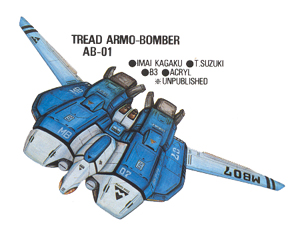
Tactical Electronic Warfare System (TEWS):
(VF-12A and -B models)
- Marconi Radar Warning Receiver (RWR)
- OlDelft Infra-red Warning Receiver (IRWR)
- Westinghouse ALQ-248 (V) active radar jammer
- Smoke and chaff dispensers
- Flares.
(VE-12A and -S and VF-12S models)
- Westinghouse ALQ-258 (V) multi-channel wide-band radar detector/jammer
- OlDelft Infra-red Warning Receiver (IRWR)
- Westinghouse QRC-100 Infra-red Counter Measures (IRCM)
- Smoke and chaff dispensers
- Active jammer dispensers
- Flares.
Electronic Masking Systems (VF-12S and VE-12S models only):
- RRG mk2B Shadow cloaking device: four-dimensional distortion field generator (downshifts and dampens protoculture radiation)
- RRG mk3 EM-absorbing skin cover, strongly absorbing EM radiation from radio through ultra-violet wavelengths, and emitting only weakly in these wavebands.
VII. Armament:
Cannons:
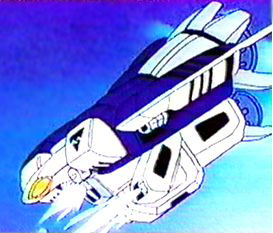
- 1 (Fighter and VTOL mode only) EP-14 three-barreled 80mm particle gun pod, firing 170 pulses per minute in full automatic mode, also capable of firing semi-automatic three-barrel blasts approximately once per second. This weapon fires 4.1 MJ pulses per barrel in each mode, drawing power from the aircraft's main energizers. This gun is a
'carbine' version of the successful EP-13 gun pod in the later model Alphas, and due to its smaller size, its energy and range are appreciably reduced. The gun is mounted internally in the center fuselage intake beneath the cockpit. The center gun is not available when the Alpha and Beta are joined.
- 2 (Fighter mode only) x EP-4 single-barreled particle cannon, capable of firing 9 MJ of particle energy every second, drawing power from the aircraft's energizers. This gun is the same as that used in the early models of the VF-4
Lightning. The two guns are mounted internally in the intakes of the leg-mounted main engines.
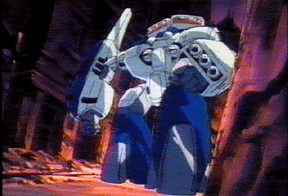
- 2 (Battloid mode only) x EU-35 triple-barreled Ion Pulse Cannon on the forearms. The maximum energy output is 12.5 MJ per barrel, with a maximum rate of fire of 45 rounds per minute. The cannon are located in the arms, with the barrels located above the Battloid's wrists. The
EU-35 can fire at higher rates of fire, but this will occur at correspondingly reduced yield.
Missiles:
(VF-12A, -B and -S models)
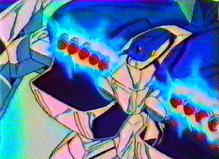
- BIMMS Beta Integral multi-missile system. The BIMMS uses four quintuple launchers for short range, Mach 3.0 combined infra-red imager and active radar homing 190mm Hammerhead missiles and four
quadruple launchers for short range (8.2 km) Mach 3.2 combined infra-red imager and active radar homing 340mm Coralsnake missiles.
The quintuple Hammerhead launch racks are located in the port and starboard forward fuselage (the 'shoulders' of the mecha) and require the aerodynamic cover to be telescoped out of the line of fire prior to launch.
 The quadruple Coralsnake launch racks are located behind the quintuple Hammerhead racks, and are built as a pop-up launcher that fires forward over the Hammerhead launch tubes.
The quadruple Coralsnake launch racks are located behind the quintuple Hammerhead racks, and are built as a pop-up launcher that fires forward over the Hammerhead launch tubes.
 Each launcher has a single reload, for a total of 40 Hammerhead and 32 Coralsnake missiles.
Each launcher has a single reload, for a total of 40 Hammerhead and 32 Coralsnake missiles.
(VE-12A and -S models)
- SIMMS Stalker Integral multi-missile system. Four quadruple launchers for short range (8.2 km) Mach 3.2 combined infra-red imager and active radar homing 340mm Coralsnake missiles. The quadruple Coralsnake launch racks are built as pop-up launchers behind the port and starboard forward fuselage (the 'shoulders' of the mecha). Unlike in the VF-12 models, there are no reloads due to the space requirements of the enhanced electronics system.
External hardpoints:
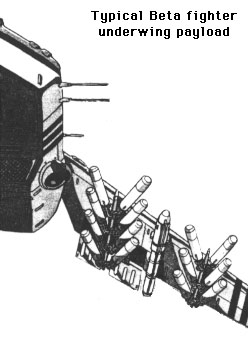
- 3 Hardpoints per wing, with multiple ordnance options. Available payloads include, but are not limited to, the following:
- Medium range (65km) Mach 3.2 combined infra-red imager and active radar homing 260mm x 1.2m Diamondback missiles. Eight such missiles can be stored on an AMER (Articulating Multiple Ejection Rack) on each inner hardpoint, seven on each middle hardpoint, and six on each outer hardpoint, for a total of up to forty-two MRMs.
- or RMS-2 "Angel Of Death II" Nuclear Stand-off missile. Reaction warhead (200 kT) mounted on a long range (293 km) Mach 4.0 combined multi-spectrum imager and active radar homing missile. Can be customized for either anti-starship or anti-hive operations. Maximum delta-v in space is 5 kps. One may be carried under each hardpoint, for a total of up to six.
- or Firebird missile. A conventional warhead mounted on the frame of a RMS missile with a range of 234 km and a speed of Mach 6.5, guided by a combined IIR,
and active/passive radar seeker. Maximum delta-v in space is 5 kps. One may be carried under each hardpoint, for a total of up to six.
- or CBM-200 cluster missiles (one per hardpoint). Two hundred guided cluster bombs with a range of 500 meters mounted on a long range (80 km) Mach 4.0 combined
multi-spectrum imager and active radar homing missile. Customized for
anti-mecha operations both in space and on the ground. Maximum delta-v in space is 3.5 kps.
- or Jammer pods, most commonly seen on the VE-12.
- or Chaff & flare dispenser pods, most commonly seen on the VE-12.
A typical mix is 28 Diamondbacks and 2 RMS-2 missiles. These hardpoints can only be used in fighter mode and must be jettisoned prior to transformation into battloid mode. Additionaly, the underwing ordnance and hardpoints cannot survive re-entry, and, indeed, would endanger the fighter should this be attempted. Likewise, orbital insetion is impossible with the wing hardpoints in use. The VE-12 Stalker is more likely to use its hardpoints since it used it transformation capabilities only as a last resort for self-defense.
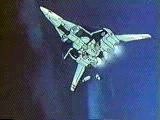
Internal weapon bay (all models except VE-12A and -S):
VIII. Armor:
The armor on the Beta is a new development in low-mass composite-materials Chobham plating that became the standard for all Terran mecha after its application to the VQ-6A Vandal. Aside from the respectable protection provided against projectiles, missiles, and
other kinetic weapons, this armor is also resistant to plasma globes annihilation discs), lasers, and to a lesser extent, particle guns, owing to the fact that the armor can flake off and evaporate in layers under fire from such high-energy weapons, taking much of the weapon's energy and converting it into the latent heat of sublimation in the armor. The armor stops all small arms, heavy infantry weapons fire, and light mecha-mounted weaponry, and provides fair to good resistance to medium mecha-mounted weaponry, such as the Valkyrie's 55mm APFSDS round. The armor on the Battloid's forearms is more formidable, being half again as thick as that elsewhere on the Beta (and comparable to the armor on the Veritech Hover Tank), allowing the pilot to use the Battloid's arms as parrying shields in close quarters.
The Beta provides full protection from nuclear, biological, and chemical hazards, using a sealed cockpit environment activated by radiation and hazardous chemical sensors, or manually when biological warfare conditions are anticipated. The internal consumables supplies can provide atmosphere for one
day maximum.
IX. Development:
Curiously enough, the Veritech Beta Fighter owes its creation to the union of two independent projects, both of which were intended to compensate for the deficiencies of the Alpha prototypes. The first such project was centered around the need to create a booster rocket that could propel the Alpha into space, and to give it greater thrust and power in extra-atmospheric operations. This booster would be aerodynamic in the atmosphere and reusable, and the Alpha could transform to Battloid without detaching from the new booster. The second project began when the need for a heavy fighter-bomber and heavy combat mecha was realized. The proposed craft, called the VF-X-7 would be half again the height of the Alpha in Battloid mode, and in fighter mode, the wingspan would be over twice as great. The fighter-bomber would carry heavier armaments than the Alpha, which mainly relied upon short-range weapons. The first project was designated the TREAD Booster, or "TRans-EArth Deployment" system, and the second was called the Beta Fighter. In late 2019, the two projects were merged, and the existing Beta fighter was born. However, the Beta's development was fraught with setbacks, and eventually a competitor design to the Beta Fighter, the VF-5 Condor, was selected for production, with the VF-X-7 Beta prototypes remaining as test-beds. This left the Alpha without an extra-atmospheric booster for the first 20 years of its existence.
It was not until 2036, when the VF-5 Condor was nearing the end of its service period, that the Beta became of particular interest again. The design team, in response to a request for proposals for a VF-5 Condor successor, redesigned the VF-X-7, and proposed the new-fanged design to the Expeditionary forces General Staff. Compared to the VF-X-7, the redesign rectified all that designs' faults, and expanded upon it with such items as reloads for the internal missile launchers, and increased reaction-mass tankage. The changes were of such magnitude, despite the near-identical external appearance, that it received a new designation, and became known as the VF-X-12 Beta Fighter. The VF-X-12 was a resounding success, and entered mass production late in 2038.
With the retirement of the VF-5 Condor as well as the AF-1B Vulture fleet defense fighter, the Expeditionary Force Naval Air Arm was in dire need of a long ranged, heavily armed, transatmospheric fighter, and thus received top priority in assignements of the Beta fighter production, despite heavy interest from the Combined Planetary Forces, which were interested in the design as a new heavy fighter and long-range bomber. Consequently, nearly all Beta fighters went to the Navy, and it was not until 2046, after the end of the Third Robotech War, that the Planetary Forces had their first Beta squadron operational.
Most significant of the Beta's abilities are its heavy armament and excellent thrust to mass ratio. These combine to make the Beta an excellent ground-attack plane, but its lack of maneuverability makes it a poor dogfighter. In addition, the vehicle is relatively unaerodynamical, and energy use in supersonic
flight is very high. The Beta possesses transatmospheric capability when it fires its boosters, and it can easily lift itself and an Alpha fighter into and out of orbit of a planetary
gravitational field. The Battloid mode can withstand enormous amounts of punishment, and is equipped with the powerful EU-35 beam cannons, located in the Battloid's forearms.
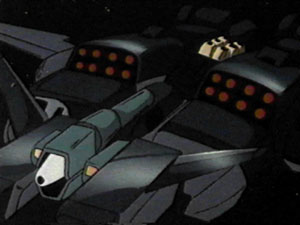
The VF-12A is the first production version of this mecha. The VF-12B is a two-seat trainer version, and the VF-12S is a stealth fighter with protoculture cloaking device and EM-absorbers. The VE-12 Stalker is an electronic warfare version of the Beta trainer. The bomb bay, most of the missile launchers, and the Coralsnake reloads are sacrificed for very extensive electronics bays and four electronics operator stations. The APY-7 radar system mounts phased arrays in numerous locations throughout the mecha, with the primary arrays in place of the Hammerhead launchers and the bomb bay doors, along the legs and along the leading edge of the wings. The Stalker is noticeably different from the Beta in that a redesigned head and sensor boom are provided. The folding optical sensor boom is replaced with an aerodynamic fixed sensor "wing" and avionics bays. The bays, taking the place where the boom folded up above the center engine, split and fold to either side of the back of the Battloid during transformation. The Stalker is almost always attached to a VF-6J Alpha Fighter to provide additional defense capabilities. The combined mecha is referred to as the Elint Legioss reconnaissance Veritech and rapidly replaced both the aging Cat's Eye and Elint Valkyrie aircraft in use by the REF due to its drastically increased survivability and additional role as a Wild Weasel in seeking out and destroying sensor installations. While attached to the Alpha, the Stalker pilot is free to assist the other five electronics operators in monitoring the mission environment. The Elint Legioss
can even support a limited airborne command, control, communications and intelligence (C3I) role. The Alpha usually also has electronic warfare pods or anti-radiation missiles on the hardpoints under its intakes.
A cloaking-device equipped Shadow version is the VE-12S. After the war, most VF-12A and VE-12A models were refitted to the VF-12S and VE-12S standards.
The Beta and Alpha can dock in less than one minute, and they can separate almost instantly. Combined with the Alpha, this fighter demonstrates incredible firepower and
speed, and makes for an exceptional piece of military hardware.
See additional design notes.
Go to additional image gallery.
Return to REF Veritech Index.
Return to Robotech Reference Home Page.
Robotech (R) is the property of Harmony Gold. This document is in no
way intended to infringe upon their rights.
Content by Pieter Thomassen, Peter Walker and Robert Morgenstern
HTML by Robert Morgenstern (rmorgens@ieee.org)
Copyright © 2001, 1999, 1997, 1995 Robert Morgenstern, Pieter Thomassen, Peter Walker


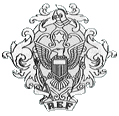
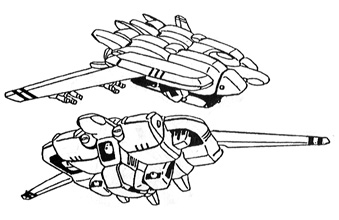






 The quadruple Coralsnake launch racks are located behind the quintuple Hammerhead racks, and are built as a pop-up launcher that fires forward over the Hammerhead launch tubes.
The quadruple Coralsnake launch racks are located behind the quintuple Hammerhead racks, and are built as a pop-up launcher that fires forward over the Hammerhead launch tubes.
 Each launcher has a single reload, for a total of 40 Hammerhead and 32 Coralsnake missiles.
Each launcher has a single reload, for a total of 40 Hammerhead and 32 Coralsnake missiles.


